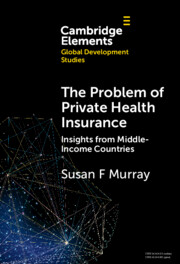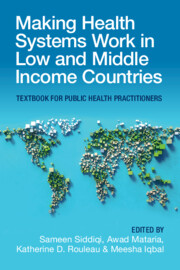Refine search
Actions for selected content:
71 results
Chapter 13 - Building Compassionate Health Systems
- from Part II - Practising Compassion
-
- Book:
- Handbook of Compassion in Healthcare
- Published online:
- 27 June 2025
- Print publication:
- 17 July 2025, pp 106-113
-
- Chapter
-
- You have access
- Open access
- HTML
- Export citation
Chapter 1 - What Is Compassion?
- from Part I - Compassion in Healthcare
-
- Book:
- Handbook of Compassion in Healthcare
- Published online:
- 27 June 2025
- Print publication:
- 17 July 2025, pp 11-18
-
- Chapter
-
- You have access
- Open access
- HTML
- Export citation
Beyond capacity limits: can social cohesion offset the impact of service constraints on youth mental health?
-
- Journal:
- European Psychiatry / Volume 68 / Issue 1 / 2025
- Published online by Cambridge University Press:
- 27 June 2025, e93
-
- Article
-
- You have access
- Open access
- HTML
- Export citation
Challenges to women’s cancer control in Morocco: a qualitative study of lay advisors and civil society perspectives
-
- Journal:
- Primary Health Care Research & Development / Volume 26 / 2025
- Published online by Cambridge University Press:
- 16 June 2025, e47
-
- Article
-
- You have access
- Open access
- HTML
- Export citation
3 - Latin American Social Medicine, across the Waves
-
-
- Book:
- Medicine on a Larger Scale
- Published online:
- 05 May 2025
- Print publication:
- 22 May 2025, pp 60-80
-
- Chapter
-
- You have access
- Open access
- HTML
- Export citation
HTA responsiveness to today’s challenges to health systems: a responsible innovation in health perspective
-
- Journal:
- International Journal of Technology Assessment in Health Care / Volume 41 / Issue 1 / 2025
- Published online by Cambridge University Press:
- 03 March 2025, e16
-
- Article
-
- You have access
- Open access
- HTML
- Export citation
Perceptions of primary care services among Afro-Peruvians in Lima, Peru
-
- Journal:
- Primary Health Care Research & Development / Volume 26 / 2025
- Published online by Cambridge University Press:
- 31 January 2025, e9
-
- Article
-
- You have access
- Open access
- HTML
- Export citation
The impact of task-sharing scalable mental health interventions on non-specialist providers: a scoping review
-
- Journal:
- Cambridge Prisms: Global Mental Health / Volume 11 / 2024
- Published online by Cambridge University Press:
- 13 January 2025, e134
-
- Article
-
- You have access
- Open access
- HTML
- Export citation
Exploring health worker absenteeism at public healthcare facilities in Chhattisgarh, India
-
- Journal:
- Primary Health Care Research & Development / Volume 25 / 2024
- Published online by Cambridge University Press:
- 17 October 2024, e44
-
- Article
-
- You have access
- Open access
- HTML
- Export citation
Providers’ experience on essential health services in primary healthcare units of Ethiopia during COVID-19: a qualitative study on impact and response
-
- Journal:
- Primary Health Care Research & Development / Volume 25 / 2024
- Published online by Cambridge University Press:
- 24 September 2024, e33
-
- Article
-
- You have access
- Open access
- HTML
- Export citation
Reimagining Vaccine Access for Health Equity
-
- Journal:
- Journal of Law, Medicine & Ethics / Volume 52 / Issue 2 / Summer 2024
- Published online by Cambridge University Press:
- 22 October 2024, pp. 480-483
- Print publication:
- Summer 2024
-
- Article
-
- You have access
- Open access
- HTML
- Export citation

The Problem of Private Health Insurance
- Insights from Middle-Income Countries
-
- Published online:
- 15 March 2024
- Print publication:
- 11 April 2024
-
- Element
- Export citation
23 - Mapping COVID-19 Legal Responses: A Functionalist Analysis
- from Part VI - Global Responses to COVID-19
-
-
- Book:
- COVID-19 and the Law
- Published online:
- 27 October 2023
- Print publication:
- 09 November 2023, pp 354-366
-
- Chapter
-
- You have access
- Open access
- HTML
- Export citation
Chapter 32 - Integrating Essential Public Health Functions in Health Systems
- from Section 2 - Transforming Health Systems: Confronting Challenges, Seizing Opportunities
-
-
- Book:
- Making Health Systems Work in Low and Middle Income Countries
- Published online:
- 08 December 2022
- Print publication:
- 29 December 2022, pp 496-510
-
- Chapter
- Export citation
Chapter 31 - The Determinants of Health Systems
- from Section 2 - Transforming Health Systems: Confronting Challenges, Seizing Opportunities
-
-
- Book:
- Making Health Systems Work in Low and Middle Income Countries
- Published online:
- 08 December 2022
- Print publication:
- 29 December 2022, pp 479-495
-
- Chapter
- Export citation
Chapter 15 - Universal Health Coverage and Beyond
- from Section 2 - Transforming Health Systems: Confronting Challenges, Seizing Opportunities
-
-
- Book:
- Making Health Systems Work in Low and Middle Income Countries
- Published online:
- 08 December 2022
- Print publication:
- 29 December 2022, pp 225-240
-
- Chapter
- Export citation
Chapter 30 - Achieving Health-Related Sustainable Development Goals
- from Section 2 - Transforming Health Systems: Confronting Challenges, Seizing Opportunities
-
-
- Book:
- Making Health Systems Work in Low and Middle Income Countries
- Published online:
- 08 December 2022
- Print publication:
- 29 December 2022, pp 464-478
-
- Chapter
- Export citation
Chapter 23 - Using Health Research for Evidence-Informed Decisions in Health Systems in L&MICs
- from Section 2 - Transforming Health Systems: Confronting Challenges, Seizing Opportunities
-
-
- Book:
- Making Health Systems Work in Low and Middle Income Countries
- Published online:
- 08 December 2022
- Print publication:
- 29 December 2022, pp 354-367
-
- Chapter
- Export citation
European interprofessional postgraduate curriculum in palliative care: A narrative synthesis of field interviews in the region of Middle, Eastern, and Southeastern Europe and Central and West Asia
-
- Journal:
- Palliative & Supportive Care / Volume 22 / Issue 5 / October 2024
- Published online by Cambridge University Press:
- 22 December 2022, pp. 874-883
-
- Article
-
- You have access
- Open access
- HTML
- Export citation

Making Health Systems Work in Low and Middle Income Countries
- Textbook for Public Health Practitioners
-
- Published online:
- 08 December 2022
- Print publication:
- 29 December 2022
